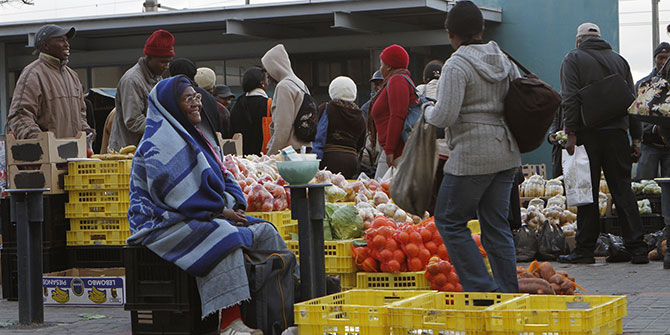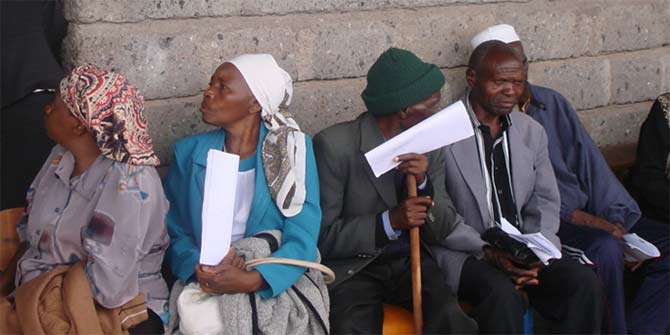Africa is among the fastest urbanising areas in the world. In this post, LSE’s Ama de-Graft Aikins explores the challenges facing the multicultural global city that is Accra and ideas of how to overcome them. This is part of a recent public lecture series exploring healthy cities in collaboration with LSE Cities and LSE Health.
In 1877, when Accra was made capital of the Gold Coast, the population was less than 20,000 and the town was dominated by one ethnic group, the Gas. When Ghana gained independence from the British in 1957, eighty years later, the population was approximately 136,000 and the Gas had lost their majority status. The first set of plans in 1944, 1958 and 1961, provided for a spacious city with well-defined residential areas, road networks and public services, in keeping with urban planning of the period. However city planners did not anticipate a rapid population increase. Now, Accra is a multi-cultural global city with a population that has doubled over the most recent national census periods, from 1.7million in 2000 to 4 million in 2010.

Early Ga settlements like La, Teshie and Mamprobi that functioned as markets for livestock and general goods, are now residential neighbourhoods which coexist with newer areas ranging from million-dollar gated communities (e.g. Trassaco Valley) to poverty-stricken slums (e.g. Old Fadama). The political dominance of the British in the development of the town (and broader Gold Coast colony) has given way to a multi-national collective of British, American, Dutch, Danish, German, Japanese and Chinese development partners who co-direct the affairs of Accra and Ghana through multi-donor support systems. Similarly the economic dominance of British companies like United Africa Company (UAC, now Unilever), has given way to a vast array of multi-national companies: in 2000, 665 companies from 80 countries had set up home in Accra. After the multi-national hotels arrived in the 1990s, the gated communities followed, and then telecommunications and entertainment industries established themselves. The fast food revolution, beginning with local hamburger joints in the 1970s and culminating in KFC’s inauguration on Accra’s Oxford Street in 2012, sealed Accra’s global status. Earlier this year, the New York Times declared Accra the fourth most desirable tourist destination for 2013, right behind Rio de Janeiro and ahead of 42 other world destinations.
Like all global cities, Accra’s fast structural and cultural rise has had an impact on the health of its inhabitants. In the late 19th century infectious disease and diseases related to poor sanitation were the dominant public health problems. By the 1920s, patient records of the newly built Korle-Bu Teaching Hospital were showing a mix of infectious diseases and chronic non-communicable diseases (NCDs), in particular chronic heart disease and stroke. A social survey conducted in the 1950s by sociologist Ione Acquah documented the top ten causes of death in Accra: infectious and parasitic diseases were the major causes of death, circulatory diseases were seventh cause of death. This trend of a “double burden of infectious and chronic diseases” and increasing importance of NCDs has persisted in subsequent surveys and in hospital records since the late 1960s. Hypertension prevalence rose almost five-fold from 7.8% in the 1970s to 37.1% in the mid-2000s among civil servants; among poor communities the rate doubled during the same period from 13% to 28%. NCD risk factors have followed similar trends. Obesity levels among women in Ghana trebled over fifteen years, from 10% in 1993 to 30% in 2008. Women in Accra have had the highest obesity levels during each survey period. In 2003, stroke was the number two cause of death, and hypertension number six. Now hypertension is the number two cause of death.
In 1971, Omran proposed a classic model of epidemiological transition which suggested that countries would transition, sequentially, from periods of high death rates due to infectious diseases to high death rates due to chronic and degenerative diseases of ageing. Various permutations of Omran’s model have been proposed. Among these, the Protracted Polarised Model of epidemiological transition, proposed by Frenk and colleagues in 1989, is regarded as the most relevant for low and middle income countries of Africa, Asia and Latin America. In this model, both infectious and chronic and degenerative diseases of ageing are major causes of morbidity and mortality. This occurs for two reasons. The “protracted” aspect of the model describes partial changes to the patterns of morbidity and mortality due to the co-existence of infectious diseases (both traditional and new) and chronic non-communicable diseases. The “polarised” aspect describes the relationship between socio-economic status and disease risk, whereby wealthy communities live with the risk of chronic diseases of lifestyle, while poor communities live with the dual risk of chronic diseases of lifestyle and infectious diseases of poverty. The public health profile of Accra over the last century has reflected the protracted polarised model of epidemiological transition. Globalisation, urban lifestyles and poverty have been implicated in these public health trends. The social determinants of Accra’s complex public health challenges, which include city planning and provision of essential public services, have received minimal attention in national health policy.
In my presentation at the LSE Cities forum on Healthy African Cities in March, I focused on Accra as a case study and suggested two approaches to conceptualising and studying healthy African cities. Definitions of healthy cities incorporate the participatory power of city inhabitants. The World Health Organisation (WHO) for example suggests that healthy cities have “a high degree of participation in and control by the citizens over the decisions affecting their lives, health and well-being”. However the majority of research prioritises the structural (top-down) aspects of designing and maintaining cities to enhance health, while the social (bottom-up) processes have received limited attention. My first suggestion was to underscore the importance of participatory social power by exploring how people live in and use their cities.
My second suggestion was to explore the utility of the concept of competence in the study of how people use cities in healthy or unhealthy ways. Competence is a concept used by a variety of disciplines and has been applied by urban sociologists, such as Richard Sennett, to theorise the symbiotic relationship between cities and their inhabitants. I began with the basic psychological definition of the competent individual, by Waters and Srouffe (1983), as one “who is able to make use of environmental and personal resources to achieve a good developmental outcome”. I suggested a multi-level approach that incorporated three elements: (1) environmental competence (the ability to deal effectively with one’s immediate surroundings), (2) social competence (the ability to deal with social heterogeneity and complexity) and self-competence (the ability to deal with polyphasic knowledge and identity). I described, using evidence from health and mental health research, how this multi-level concept could aid analysis of how Accra residents navigated rush hour traffic (environmental competence), managed complex social relationships that impinged on mental and physical health (social competence) and managed individual and health and well-being (self competence). The analysis suggested that while competence was an ideal for many Accra inhabitants (in so far as individuals used the city to their own individual ends), the availability of the right mix of resources determined whether the appropriate developmental outcomes emerged. Resources could be conceptualised as structural (e.g. one’s neighbourhood), social (e.g. the quality of one’s social network), symbolic (e.g. the desirability of the city) and psychological (e.g. health awareness and knowledge). Furthermore, competence was a double-edged sword if individual goals were short-term, self-centred and apolitical. For example poor communities experience the greatest threats of city life and possess the least resources to transcend everyday health and developmental challenges. While wealthy communities may have the resources to overcome daily challenges and call city planners and policymakers to action, their focus on immediate individual needs undermines the possibility of social transformation.
The health of cities is a major global challenge. The LSE Cities forum on Healthy African Cities was timely because a focus on African cities is crucial to these global debates. Accra is not a unique case study. Africa is one of the fastest urbanising regions in the world and urban poor populations face the greatest health threats with the least resources. Developing context-specific and locally relevant conceptual and methodological approaches will be central to understanding and addressing the rapid and complex changes to African cities that affect collective urban health.
Ama de-Graft Aikins is LSE African Initiative Fellow at LSE Health and Associate Professor of Social Psychology at the Regional Institute for Population Studies, University of Ghana.
Healthy African Cities was produced in collaboration with LSE Health and Africa Talks. It was the first in a new series of free public events on the topic of “Cities, health and well-being”. The second lecture, ‘Interdisciplinary Action for Urban Health’ took place on Friday 26 April 18.30 – 20.00 in the Thai Theatre, New Academic Building, London School of Economics and Political Science. For more information please visit our website.
LSE Cities is an international centre at the London School of Economics and Political Science supported by Deutsche Bank that carries out research education and outreach activities in London and abroad. Its mission is to study how people and cities interact in a rapidly urbanising world, focusing on how the design of cities impacts on society, culture and the environment. Through research, conferences, teaching and projects, the centre aims to shape new thinking and practice on how to make cities fairer and more sustainable for the next generation of urban dwellers, who will make up over 70 per cent of the global population by 2050.






1 Comments